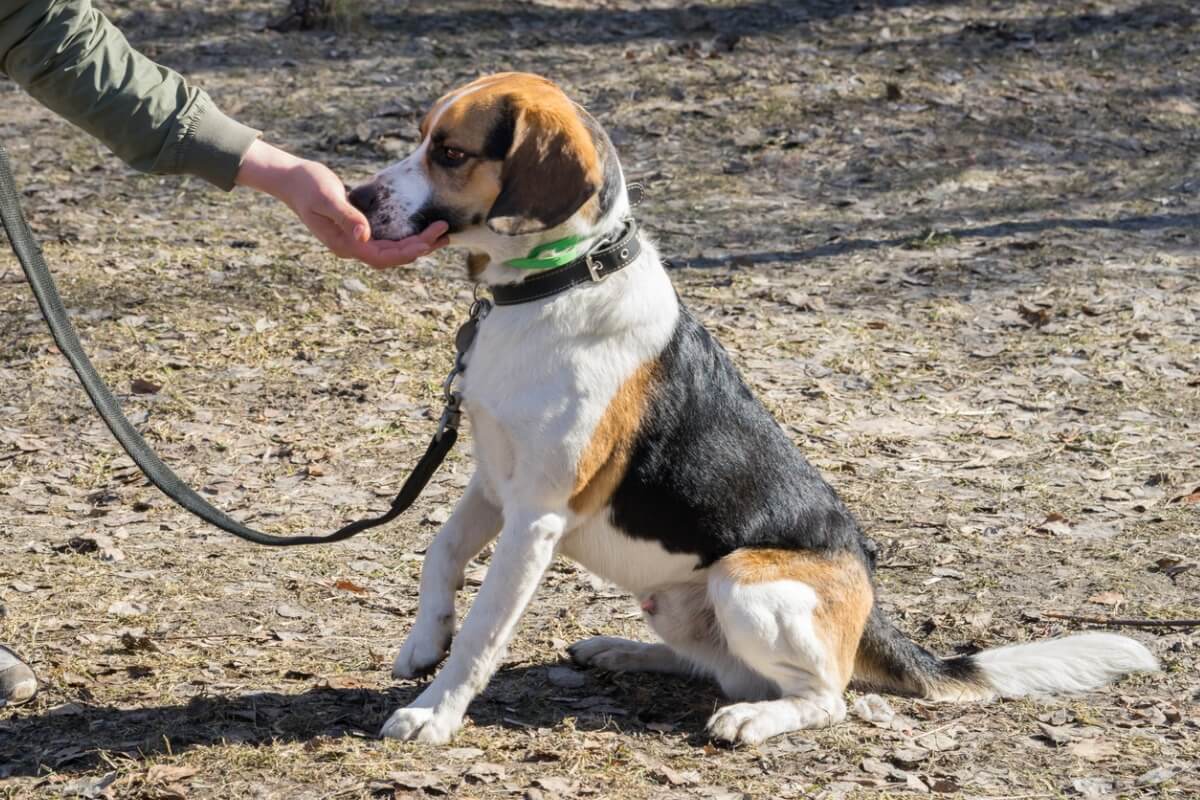The Correct Use of Dog Training Collars

Dog training collars are tools used to teach the animal to perform certain actions or, on the contrary, to avoid certain behavior that must be corrected. However, you need to learn to use the training collar correctly in dogs so as not to harm them in the process.
If not used properly, this tool could harm the dog, getting negative responses from them in the process. Also, no matter how good it has been throughout its training, it shouldn’t be used continuously throughout the dog’s life. Here we’ll tell you more about this type of collar and when to use it.
What are dog training collars?
Dog training collars are accessories that you place on the animal’s neck and their purpose is to control and modulate the dog’s behavior more or less remotely. The correct use of the training collar on dogs won’t cause them any pain or harm, and so you need to have a good knowledge of this device and how to operate it.
In addition to this, during the time that you use the collar, positive reinforcement training should also be used. Only then will the most optimal results be achieved for pets and guardians alike.

Types of dog training collars
There are different types of dog training collars. Among them, the following stand out.
Hanging, or choke collars
The way hanging collars are designed allows them to close around the animal’s neck and for the pressure to be released very quickly. In this way, the force exerted when the dog performs certain behavior will be rapidly increased.
The difference between a hanging collar and a semi-hanging collar is that the latter exerts less total pressure, so they’re safer if you aren’t used to using them.
Spiked collars
The operation of spiked collars is the same as that of the choke collars, except that these ones have one particular characteristic. They have a series of teeth on the inside, and these exert pressure on the dog’s neck when you pull it.
Unlike the choker, the spiked training collar can’t be stopped beyond a certain point, and so its use is almost always discouraged. It can do a lot of harm to the animal.
Electronic collar
The electronic training collar can be controlled by the trainer or the tutor remotely through a remote control. In general, this accessory emits certain stimuli that can vary in intensity and duration. Within this category there are different models, among which we have the following:
- Those that emit electrical impulses, such as shocks or vibrations.
- Those that produce ultrasound.
- And, finally, some collars spray a jet of water towards their snout.
Now that we know all about the different types of dog training collars, the guidelines for their proper use should be clear.
Tips for the correct use of the training collar in dogs
It’s possible to use the dog training collar correctly, as long as certain considerations are taken into account.
The characteristics of the dog
The first step when choosing a training collar is to take into account the morphological characteristics of the dog. For example, its breed, size, weight, and neck strength.
On the other hand, you also need to know each dog’s training needs. This is so because some dogs find it much less difficult to follow orders than others. Using a collar may not be the best option for certain breeds of dogs.
Familiarization with the collar
Before starting to use the collar, the dog must get used to wearing it around his neck and it must become familiar with its touch and weight. Therefore, you’ll need to put it on for a while without actually using it or connecting it.
Collar placement
Ensuring a good placement of the collar is essential. By doing this properly, the dog will react to the slightest pressure or impulse without increasing the applied force.
To ensure this, the collar must be high and well adjusted, that is, in contact with the animal’s skin over its entire surface. Of course, you mustn’t squeeze it to avoid chafing.
We need to highlight that the function of these necklaces is to warn and not to harm. If the signals you send (applying pressure or sending electrical or sound impulses) never work, the collar may be incorrectly fitted.
Use it only after disobedience
Starting the collar mechanism, of whatever type, should only be done after disobedience. This means that a basic command has to be given to the dog and, just in case it does not comply with it, the electronic impulse will be sent or the collar will be pulled.
Stimulus intensity selection
In electric collars, there are different stimulus intensities. To choose the right one, you always have to take into account the characteristics of the dog, both physical and behavioral. An intensity level 5 won’t affect a 12-kilogram dog the same as a 30-kilogram dog. Keep their needs in mind and always start from less to more.
Instantaneous pressure
The impulse or pressure must be carried out for a short moment. Only in this way will the negative stimulus be effective without causing injury to the animal. If you’re not clear about the limits, ask a dog trainer for help.
No need to tighten the belt
For the correct use of the dog training collar, whether it’s the choke or semi-choke type, you should never walk with the leash taut. As mentioned in the previous point, you only have to pull it in specific moments of disobedience and for a very short time.
Don’t leave the dog with the training collar on unattended
It isn’t advisable to leave the dog with this type of collar on unattended. Imagine how dangerous it can be if they have a hanging collar and it gets caught somewhere. For the same reason, the animal should never be tied up with this type of collar without supervision.
On the other hand, as for the collar that sends stimuli, we mustn’t leave the remote lying around. A child may pick it up and start to use it without knowing what it is. Even in a bag, it might activate on its own. In both scenarios, the device would cause serious damage to the animal.
When is the use of the training collar recommended?
Despite having clear guidelines for the correct use of the dog training collar, it shouldn’t always be used. The most advisable thing is to restrict its use to the following scenarios:
- In very large and energetic animals that are difficult to control by their guardian.
- In young dogs, but always older than 6 months and during the first walks.
- To teach basic and very specific rules, especially those related to walks. Special collars shouldn’t be used for all types of training.

Don’t forget that these accessories have a specific purpose and that they aren’t very pleasant for the dog. Their goal is to train, not to punish. For this reason, in addition to wearing it only at certain times during their training, it’s advisable to combine it with a normal walking collar. Remember that the learning process doesn’t have to be painful for your animal.
All cited sources were thoroughly reviewed by our team to ensure their quality, reliability, currency, and validity. The bibliography of this article was considered reliable and of academic or scientific accuracy.
- How to Use an Electronic Dog Training Collar. Recogido el 12 de septiembre en https://www.wikihow.com/Use-an-Electronic-Dog-Training-Collar
- Collar electrónico para el entrenamiento canino. Recogido el 12 de septiembre en https://hugepdf.com/download/el-collar-electronico-para-el-entrenamiento-canino-en_pdf
- How to Use a Dog Training Collar? Recogido el 12 de septiembre en https://www.thedogline.com.au/electric-dog-collar/remote-training-collar/how-to-use-a-remote-dog-trainer
- Muñoz, T. A. (2020). ADIESTRAMIENTO CANINO: MANUAL DE UN PERRO EQUILIBRADO [Libro electrónico].
- How To Use A Dog Training Collar. Recogido el 12 de septiembre en https://www.barkva.org/how-to-use-a-dog-training-collar/
